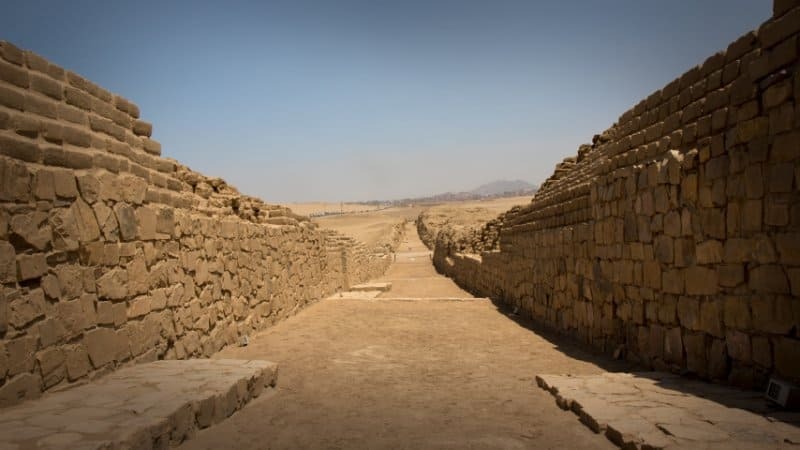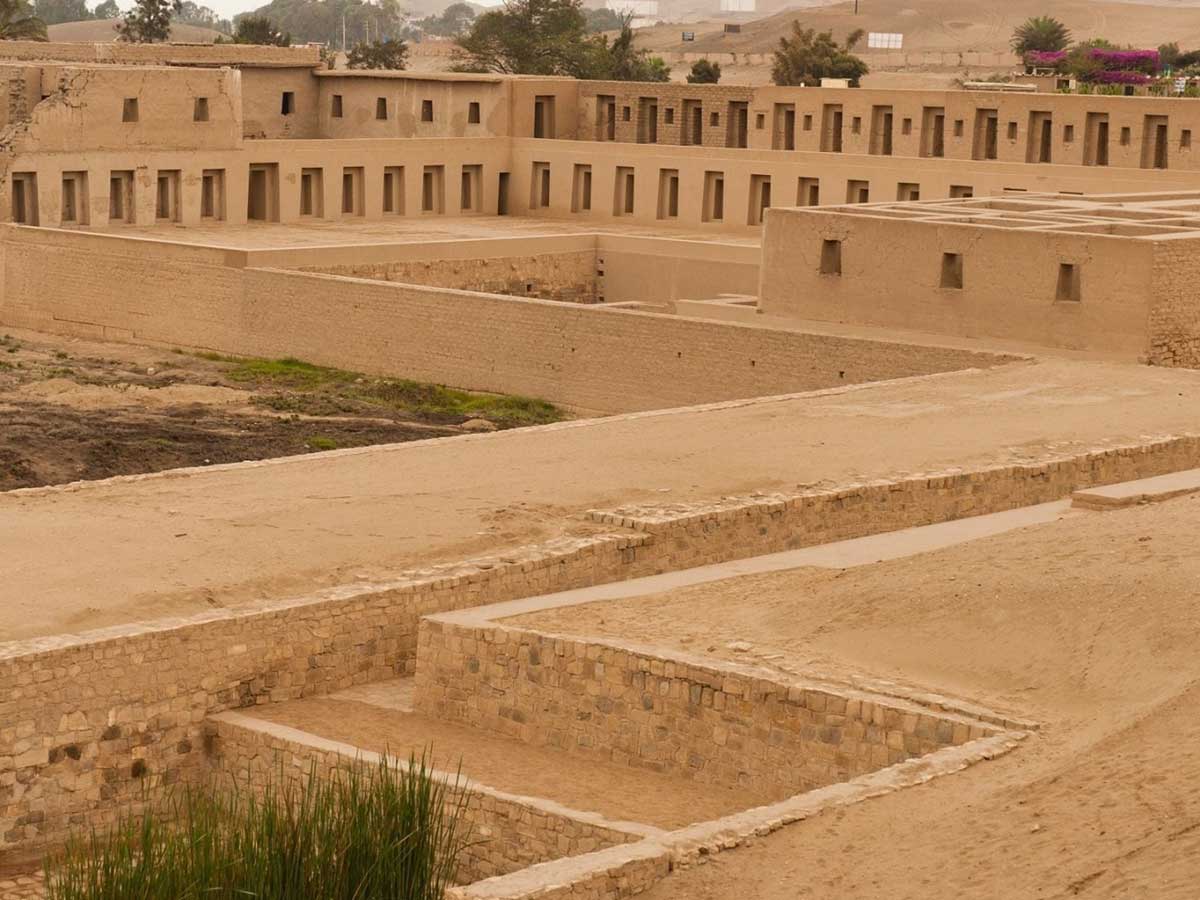

Located south of Lima, the archaeological site of Pachacámac is one of the most extensive and important on the coast of Peru. This ancient ceremonial center spans more than 465 hectares and was in continuous use for approximately 1500 years, from the first centuries of our era until the arrival of the Spanish in 1533. Vestiges of the Lima, Wari, Ychma, and Inca cultures can be seen at the site. Of these, the Ychma culture was the main builder of the ramped pyramids that still rise today above the arid landscape of Pachacámac Peru.
The complex includes temples, palaces, squares, streets, aqueducts, and cemeteries, with the Temple of the Sun and the Temple of Pachacámac among its main structures. The latter was the center of worship for the god Pachacámac, a deity feared for his ability to cause earthquakes. His original idol was found at the site and is currently preserved in the Pachacámac Site Museum, which also exhibits ceramics, textiles, and other objects recovered during excavations.
For those seeking different experiences in Pachacámac Lima, a "special visit" can be requested at the entrance, which includes limited-access areas such as one of the 16 ramped pyramids and the ancient ceremonial street. This visit requires hiring a local guide and is done entirely on foot, offering a more detailed perspective of the place.
Pachacamac is the largest archaeological site in Lima. It was an important religious center since pre-Inca times, in which there are remains of different peoples and cultures from about 2,000 years ago. The Lima, Huari and Ichma cultures passed through there until the arrival of the Incas, who remodeled it and built their main temples. With the arrival of the Spanish, the sanctuary was abandoned.
The archaeologist Max Uhle made the first archaeological excavations in 1897, focusing mainly on the Temples of the Sun andthe Moon. Later, many other archaeologists have worked on the site discovering new buildings and remains of those cultures.
Pachacámac is located south of the Peruvian capital, approximately 40 kilometers from the center of Lima and 30 kilometers from Miraflores. This archaeological site extends close to the coast, in front of the islands known by the same name. Although today Lima's urban expansion has reached the surroundings of the Pachacámac ruins, the place retains its historical and cultural value. The Pachacámac temple and the structures that surround it continue to be an essential part of the tourist routes that stand out among the things to do in Pachacámac.
The archaeological site of Pachacámac is one of the most fascinating destinations for those who wish to discover the pre-Hispanic history of the central coast. Walking through the ancient ruins of Pachacámac is an experience that allows you to explore centuries of history and closely observe the temples and pyramids that were part of this important ceremonial center.
Among the most prominent points are the Old Temple, the Painted Temple, the Temple of the Sun, and the Temple of the Moon. The Old Temple, belonging to the Lima culture, is the oldest structure in the complex. Although it is deteriorated, parts made with small adobes are still preserved. Next to it is the Painted Temple, where polychrome murals with human figures, animals, and vegetation were found.
The Temple of the Moon, also known as Mamaconas or Acllawasi, was built by the Inca Empire and served as a residence for women selected for their skills. Thanks to a restoration process, today it is possible to appreciate the architecture of this ceremonial space.
For its part, the Temple of the Sun is the largest building in the ruins of Pachacámac Peru. It rises on a hill with a direct view of the Pacific Ocean and nearby islands. Although part of the temple remains restricted, a section can be visited that allows observing the magnificence of Inca engineering.

According to this legend, there was a beautiful woman, Cavillaca, who was wanted by the gods. As she was not fooled by any, the god Wiracocha became a bird and spread her seed on a fruit tree. She, by eating the fruit, became pregnant. No one knew who the father of the woman's daughter was, until the girl was asked to recognize her father, and she recognized the god Wiracocha.
The god, to go unnoticed, had dressed in rags, so the woman thought that a poor ragged man was the father of her daughter and she felt so upset that she went to the ocean to kill herself with the little girl. The god tried to stop her, revealing who she was, but she no longer wanted to know anything about her and when they got into the sea they ended up turned into stone due to her vanity.
In addition to visiting the temples located in the archaeological site, you cannot leave the site without visiting the Site Museum. Some 6,500 very beautiful and well-preserved pieces belonging to the cultures that have inhabited this place are kept there. Among these pieces you will see the Idol, a carved wooden figure found among the remains of the Painted Temple that was the representation of the god Pachacamac and the reason for the existence of the entire sanctuary.

Being the largest archaeological site in Lima, there are certain places to pay special attention to when visiting Pachacamac. Some of its temples stand out, but you cannot miss the Site Museum either, with a large collection of objects found in the enclosure belonging to the different cultures that inhabited it.
How can you know all this I am talking about? As I was saying, the archaeological site of Pachacamac is very close to the Peruvian capital, so I recommend that, when traveling alone to Lima, make a hole in your schedule to go there.
As the sanctuary is located on the outskirts of Lima, it is easy to visit it in half a day. You can do it with a guided tour, thanks to which you won't have to worry about how to get there and you'll have the ticket included. If you are interested in visiting another museum, you have the option of also visiting the Larco Museum or the Gold Museum optionally on the same tour.
It is also possible to arrive on your own, either with your vehicle or by bus. Lines 8504, 8508 and 8511 leave from the center of Lima and stop in front of the archaeological site. Now, because it takes a long time and may not be secure, I don't recommend this option. It is easier to hire the tour.
Peru offers a variety of routes that allow you to discover its landscapes, living cultures, and archaeological treasures. From ancient Inca trails to jungles full of biodiversity, each route offers a unique glimpse into the country's richness. Whether among mountains, valleys, or deserts, each experience promises memorable recollections and a direct connection with Peru's history and nature.
If you want to visit Machu Picchu, we recommend you to book your Machu Picchu Entrance Tickets in advance, so you will enjoy your Vacation in Machu Picchu without any problem.